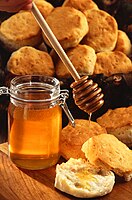
Photo from wikipedia
Abstract Background Consumers are increasingly concerned with high sugar and aging quality in bread. The use of sugar alcohols as sugar replacers in bakery products is a common practice, due… Click to show full abstract
Abstract Background Consumers are increasingly concerned with high sugar and aging quality in bread. The use of sugar alcohols as sugar replacers in bakery products is a common practice, due mainly to their modulating process properties, improving quality and health benefits. They are not only sweeteners with reduced-calorie, commonly used in combination with other sweeteners to achieve desirable taste and sweetness level, but also improvers for bread and other cereal foods to obtain a stable and strong network, retard staling, good taste and longer shelf-life. Scope and approach The review summarized the effects of sugar alcohols on dough rheological properties, elucidated the rate of fermentation and specific volume, illustrated moisture distribution and migration, analyzed the retrogradation in sugar alcohol-bread, and further provide insights in utilization of sugar alcohols in bakery industry. Key findings and conclusions Molecule structure, size and level of sugar alcohols in bread could affect dough rheological characterization, starch pasting, gelatinization, and retrogradation, and further have an effect on bread quality. Such effects might be contributed to hydrogen bonds formed between hydroxyl groups in sugar alcohols and starch chains. Starch retrogradation and water migration are two main factors played key role in influencing bread staling. Sugar alcohols are highly associated with moisture migration and redistribution further to affect bread aging and quality. However, information in the above area is limited. The mechanism of action in antistaling and/or starch recrystallization in bread influenced by sugar alcohols will be explored in this review.
Journal Title: Trends in Food Science and Technology
Year Published: 2021
Link to full text (if available)
Share on Social Media: Sign Up to like & get
recommendations!